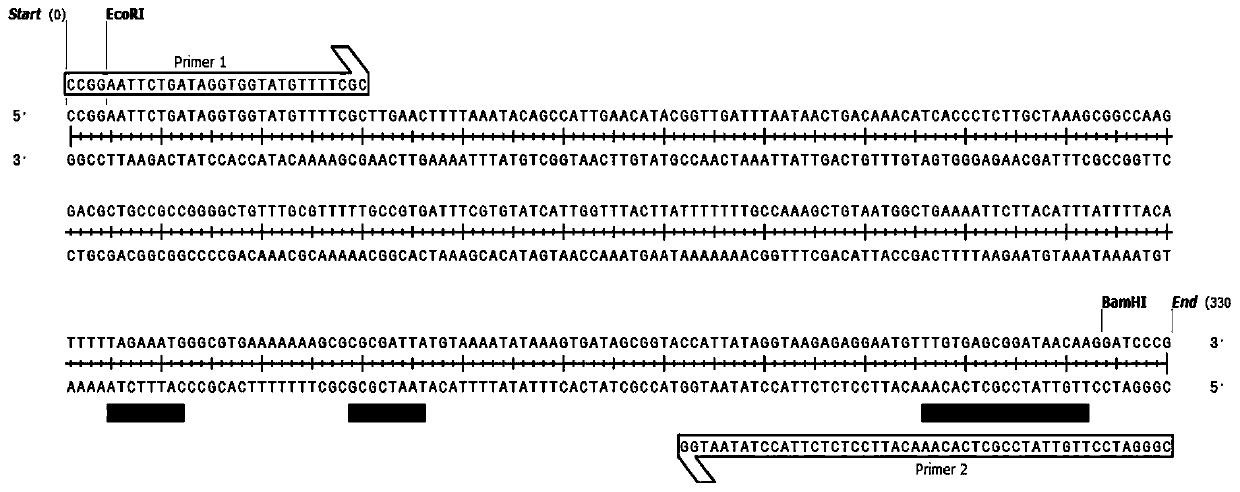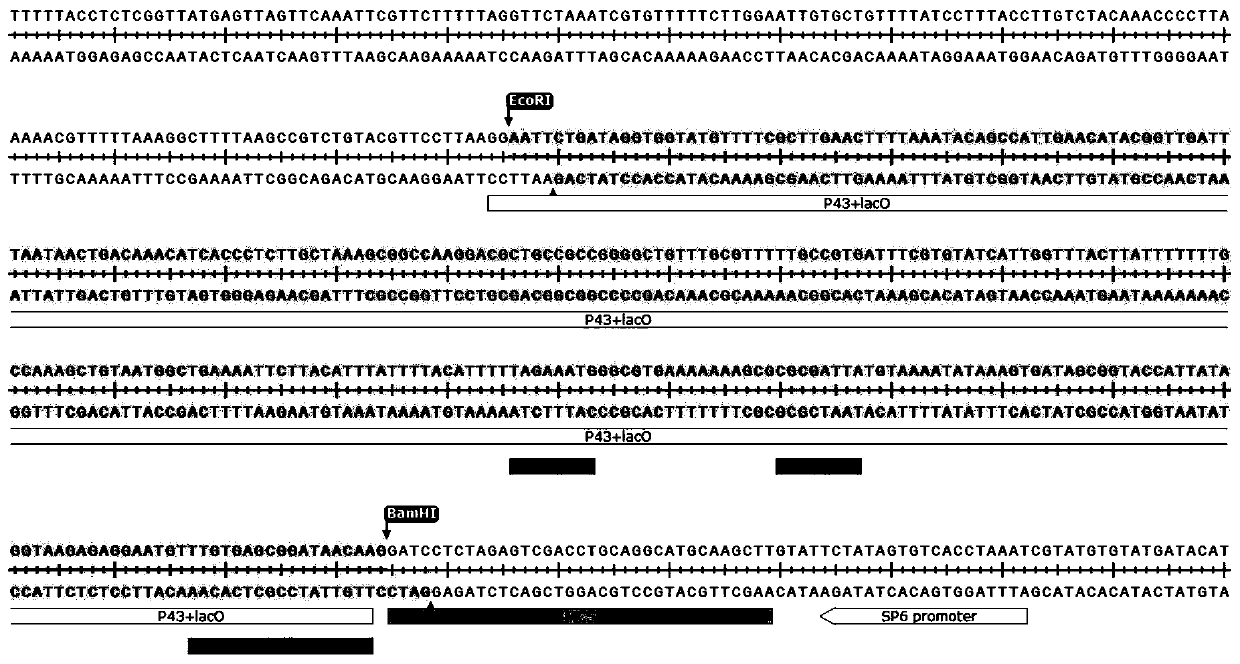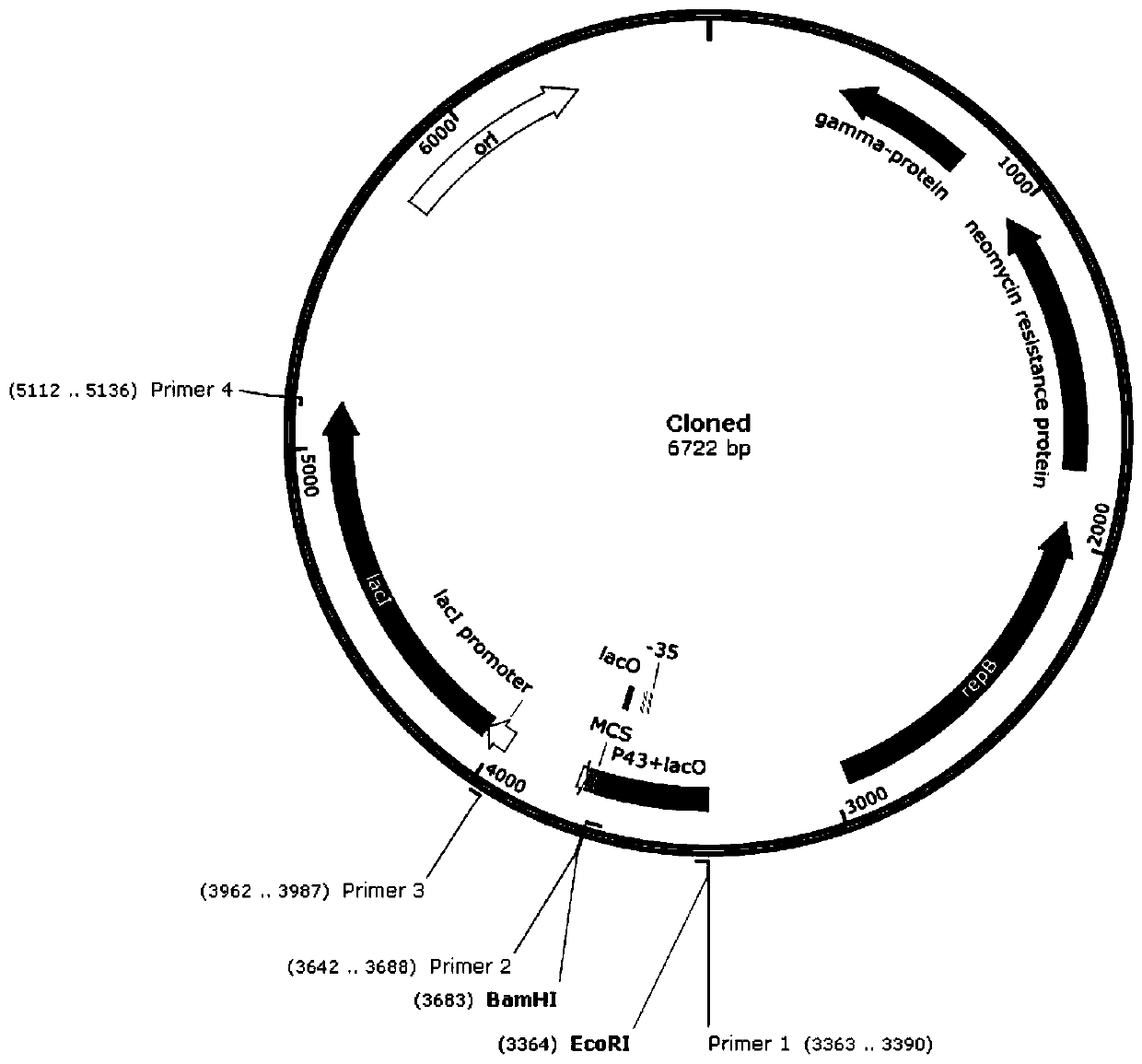Recombinant plasmid and preparation method thereof, and preparation method and applications of cell prepared by using recombinant plasmid and capable of expressing high temperature-resistant alpha-amylase
A technology of recombining plasmids and high temperature resistance, which is applied in the field of biological genetic engineering to achieve the effects of fast production speed, increased yield, and clear genetic information
- Summary
- Abstract
- Description
- Claims
- Application Information
AI Technical Summary
Problems solved by technology
Method used
Image
Examples
Embodiment 1
[0050] A kind of recombinant plasmid, the gene sequence that it contains is shown as SEQ ID NO: 3, and described recombinant plasmid is with Bacillus subtilis-E. P43 promoter and lacO gene, and LacI gene inserted at its NheI and PvuI multiple cloning sites.
[0051] The preparation method of the recombinant plasmid comprises the following steps:
[0052] (1) Using the Bacillus subtilis-Escherichia coli shuttle plasmid pBE2 vector as the backbone, use EcoRI and BamHI to carry out double enzyme digestion overnight, and recover the plasmid fragment after digestion;
[0053] (2) Using Bacillus subtilis as a template, use the primer P1 containing the EcoRI restriction site and the primer P2 containing the lacO and BamHI restriction site to amplify the P43 promoter sequence to obtain the lacO gene connected to the promoter P43 ; Its gene sequence is shown in SEQ ID NO: 1, and the connection schematic diagram is shown in Figure 1;
[0054] The gene sequences of the primers P1, P2, P4...
Embodiment 2
[0072] A method for preparing cells capable of expressing high-temperature-resistant α-amylase, the preparation method comprising the following steps:
[0073] (a) Ligate the high temperature resistant α-amylase gene into the recombinant plasmid in Example 1, and transform the ligated product into Escherichia coli DH5a, and use neomycin for resistance screening to obtain the high temperature resistant α-amylase gene Gene carrier; specifically:
[0074] (a-1) According to the Bacillus subtilis thermostable α-amylase gene sequence published by NCBI, design primers, use Bacillus subtilis strain as template, use primer P5 with BamHI restriction site and XbaI enzyme The primer P6 at the cleavage site amplifies the high temperature resistant α-amylase gene, and the obtained high temperature resistant α-amylase gene sequence is shown in SEQ ID NO:4.
[0075] The gene sequences of the primers P5 and P6 are as follows:
[0076] P5: CG GGATCC ACATTGAAAGGGGAGGAGAAT;
[0077] P6: GC ...
Embodiment 3
[0090] Application of cells capable of expressing thermostable α-amylase in production of thermostable α-amylase
[0091] Add the cells capable of expressing high-temperature-resistant α-amylase obtained in Example 2 into a Erlenmeyer flask filled with 50 mL of LB culture medium at a ratio of 1:100, and culture with shaking at 37°C and 250 r / min for 16 hours. Collect the culture supernatant for SDS-PAGE, such as Figure 4 As shown in the figure, one more band around 50KD can be seen in the figure, indicating that the recombinant amylase gene has been expressed in the cell.
[0092] Enzyme extraction and purification: collect the fermentation broth, centrifuge at 3000r / min for 10min, remove the bacteria, add 65% saturated ammonium sulfate to the supernatant, wait until the ammonium sulfate is fully dissolved, salt out at 4°C for 2 hours, then 5000r / min min and centrifuged for 30 min to obtain the crude enzyme that was initially purified.
PUM
 Login to View More
Login to View More Abstract
Description
Claims
Application Information
 Login to View More
Login to View More - R&D Engineer
- R&D Manager
- IP Professional
- Industry Leading Data Capabilities
- Powerful AI technology
- Patent DNA Extraction
Browse by: Latest US Patents, China's latest patents, Technical Efficacy Thesaurus, Application Domain, Technology Topic, Popular Technical Reports.
© 2024 PatSnap. All rights reserved.Legal|Privacy policy|Modern Slavery Act Transparency Statement|Sitemap|About US| Contact US: help@patsnap.com










